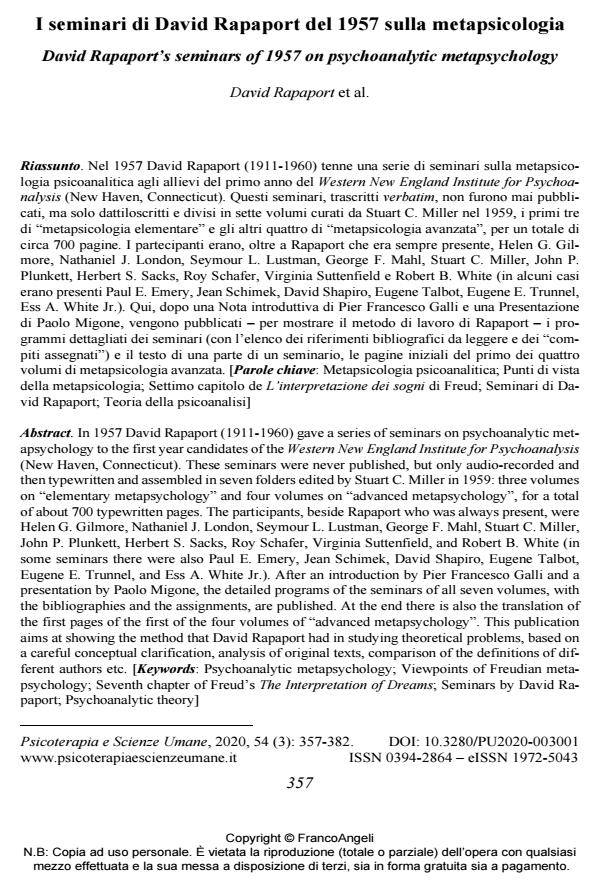David Rapaport’s seminars of 1957 on psychoanalytic metapsychology
Journal title PSICOTERAPIA E SCIENZE UMANE
Author/s David Rapaport
Publishing Year 2020 Issue 2020/3
Language Italian Pages 3 P. 357-359 File size 22 KB
DOI 10.3280/PU2020-003001
DOI is like a bar code for intellectual property: to have more infomation
click here
Below, you can see the article first page
If you want to buy this article in PDF format, you can do it, following the instructions to buy download credits

FrancoAngeli is member of Publishers International Linking Association, Inc (PILA), a not-for-profit association which run the CrossRef service enabling links to and from online scholarly content.
In 1957 David Rapaport (1911-1960) gave a series of seminars on psychoanalytic metapsychology to the first year candidates of the Western New England Institute for Psychoanalysis (New Haven, Connecticut). These seminars were never published, but only audio-recorded and then typewritten and assembled in seven folders edited by Stuart C. Miller in 1959: three volumes on "elementary metapsychology" and four volumes on "advanced metapsychology", for a total of about 700 typewritten pages. The participants, beside Rapaport who was always present, were Helen G. Gilmore, Nathaniel J. London, Seymour L. Lustman, George F. Mahl, Stuart C. Miller, John P. Plunkett, Herbert S. Sacks, Roy Schafer, Virginia Suttenfield, and Robert B. White (in some seminars there were also Paul E. Emery, Jean Schimek, David Shapiro, Eugene Talbot, Eugene E. Trunnel, and Ess A. White Jr.). After an editorial note and an introduction, the detailed programs of the seminars of all seven volumes, with the bibliographies and the assignments, are published. At the end there is also the translation of the first pages of the first of the four volumes of "advanced metapsychology". This publication aims at showing the method that David Rapaport had in studying theoretical problems, based on a careful conceptual clarification, analysis of original texts, comparison of the definitions of different authors etc.
Keywords: Psychoanalytic metapsychology; Viewpoints of Freudian metapsychology; Seventh chapter of Freud’s The Interpretation of Dreams; Seminars by David Rapaport; Psychoanalytic theory
David Rapaport, I seminari di David Rapaport del 1957 sulla metapsicologia in "PSICOTERAPIA E SCIENZE UMANE" 3/2020, pp 357-359, DOI: 10.3280/PU2020-003001